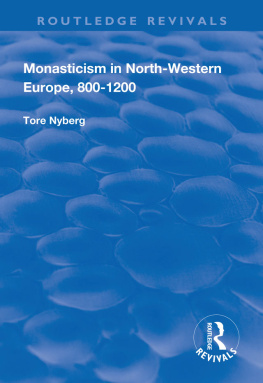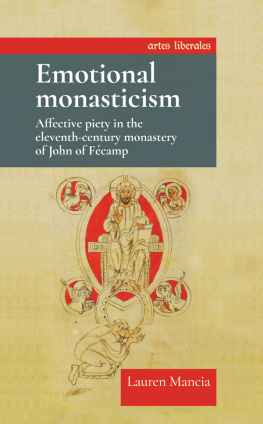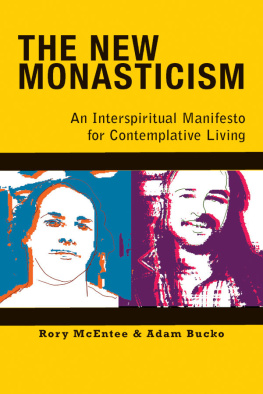Monasticism in North-Western Europe, 800-1200
About the volume:
This is a full-scale integrated synthesis of the origins, spread and effects of monasticism in Scandinavia, and along the shores of the Baltic and the North Sea, against the background of the struggle between Christian and non-Christian traditions.
Beginning with a review of the geography and communications by land and, especially, by sea, of the region, Tore Nyberg goes on to describe early monasticism among the Frisians, Saxons and the Danes, then in Norway and Sweden, Saxony, Slesvig and Ribe, and finally in Pomerania and the southern Baltic littoral up to AD 1200.
Throughout the book the author stresses the place of abbeys and convents within their local surroundings, as centres of conversion, recruitment and redistribution of wealth. He traces the intellectual, literary and liturgical connections between monastic centres and neighbouring cathedral towns and royal strongholds, and the means by which orders or congregations maintained discipline from the centre. He also describes the leaders who emerged from convent, abbey or congregation to command local and regional political and cultural life, and the ways in which monastic centres influenced popular devotion.
The book throws new light on subjects such as the survival of paganism and the development of Christian kingship, and demonstrates that early Scandinavian church history has greater coherence than has hitherto been suggested.
About the editor:
Tore Nyberg has been responsible for research and teaching in medieval history at the Institute of History and Western Civilization at the University of Southern Denmark, Odense, since 1970.
Monasticism in North-Western Europe, 8001200
Tore Nyberg
WITHDRAWN
First published 2000 by Ashgate Publishing
Reissued 2018 by Routledge
2 Park Square, Milton Park, Abingdon, Oxon OX14 4RN
711 Third Avenue, New York, NY 10017, USA
Routledge is an imprint of the Taylor & Francis Group, an informa business
Copyright Tore Nyberg, 2000
The author has asserted his moral right under the Copyright, Designs and Patents Act, 1988, to be identified as the author of this work.
All rights reserved. No part of this book may be reprinted or reproduced or utilised in any form or by any electronic, mechanical, or other means, now known or hereafter invented, including photocopying and recording, or in any information storage or retrieval system, without permission in writing from the publishers.
Notice:
Product or corporate names may be trademarks or registered trademarks, and are used only for identification and explanation without intent to infringe.
Publisher's Note
The publisher has gone to great lengths to endure the quality of this reprint but points out that some imperfections in the original copies may be apparent.
Disclaimer
The publisher has made every effort to trace copyright holders and welcomes correspondence from those they have been unable to contact.
Typeset in Sabon by Manton Typesetters, Louth, Lincolnshire, UK.
A Library of Congress record exists under LC control number: 00026602
ISBN 13: 978-1-138-72142-5 (hbk)
ISBN 13: 978-1-315-19454-7 (ebk)
My first expression of gratitude must go to the three initiators of monastic studies who attempted, and for the first time presented to the public, an overall picture of monasticism in their respective countries. They represented by their efforts the conscientious, but only recently awakened, scholarly ambitions of their times in Scandinavia. Andreas Rhyzelius (1677-1761), who ended his life as Bishop of Linkping, published his Monasteriologia on Swedish monastic history in 1740 (Rhyzelius, 1740). The book on Danish monasticism which the later bishop, Jacob Bragger Daugaard (1796-1861), published in 1830 was his prize essay at the Royal Society of Sciences and Letters in Copenhagen (Daugaard, 1830). In Norway it was the Director of the Royal Archives in Christiania, Christian Christoph Andreas Lange (1810-61), who created the pioneer work on Norwegian monasticism which appeared in Christiania in 1847 and, in a second edition, in 1856 (Lange, 1847). The list can be extended by adding the names of some scholars of our century who trod in the footsteps of these heroic pioneers: university teachers like the Copenhagen church historian Hal Koch (1904-63) (Koch, 1936) and scholars of the Cistercian Order like the Catholic parish priest Eduard Ortved (1855-1930) (Ortved, 1927; 1933). Lauritz Weibull (1873-1960), the great admirer of Archbishop Eskil, and Niels Skyum-Nielsen (1921-82), representatives of the 'school of historical criticism', focused upon how to understand marginal Scandinavian monasticism in the framework of medieval European church and society. One of their followers was the enthusiastic Scanian promotor of Premonstratensian studies, Curt Wallin (1908-92). In Sweden the devotion to monasticism inspired Hilding Johansson, the Lund scholar who was at home in Skara and Lidkping in western Sweden, to undertake fundamental Cistercian studies which also took into account liturgical sources.
My debt of gratitude towards Niels Skyum-Nielsen is also very personal: I had the privilege of his friendship. The writings of ke Hyenstrand and Peter Sawyer on Scandinavian society and religion at the time of the conversion to Christianity brought further inspiration. Then came the fundamental scholarly contributions of Brian Patrick McGuire, now of Roskilde, on the Cistercians in Denmark and of James France on the Cistercians in Scandinavia. Erik Cinthio, Lund, published collected studies on monasticism in Scania, yvind Lunde presented his results on monasteries in medieval Trondheim and elsewhere in Norway, and Jens Vellev, Aarhus, went on publishing new results from excavations and further studies on Scandinavian monasticism in his yearbook Hikuin, and they are joined by a number of outstanding scholars in history and archaeology whose contributions to the history of particular sites are found in the references.
The corollary of the national and regional studies was the international perspective to which above all Kaspar Elm contributed, his Ordensstudien conferences and publications bringing together students of all types of religious life in Berlin in the 1970s and 1980s. Furthermore, the new Centre Europen de Recherches sur les Congrgations et Ordres Religieux (CERCOR) in St Etienne, France, founded by the late Professor Pierre-Roger Gaussin, has meant a tremendous step forward in encouraging studies on all aspects of religious life. I am above all grateful to have been allowed to participate in this community of scholars on monasticism initiated by Professor Gaussin, with its conferences and publications.
It seemed appropriate to go beyond the frontiers of Scandinavia proper and, by including Frisia and the northernmost dioceses of Germany, to make North-Western Europe the geographical scope of this book. In this connection I am deeply indebted to Johannes Adriaan Mol, Leeuwarden, who from the perspective of the Fryske Akademy has shared with me his broad perspective upon, and detailed knowledge of, Frisian monasticism.
Last but not least I thank the Institute of History and Western Civilization and the Centre for History at the University of Southern Denmark, Odense, for providing the scholarly environment and resources for the research which led to this book.










